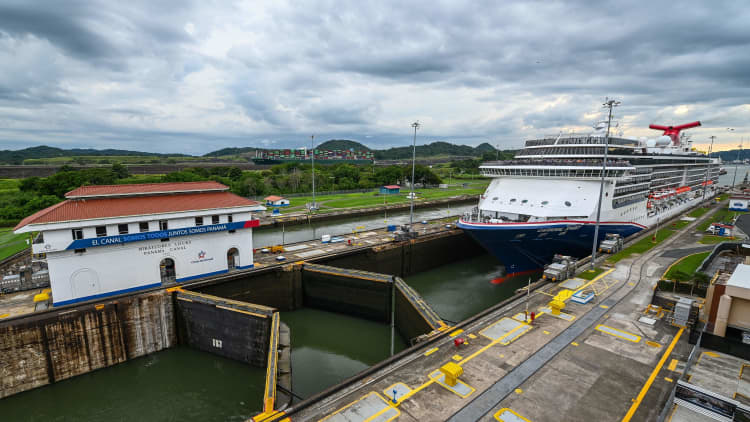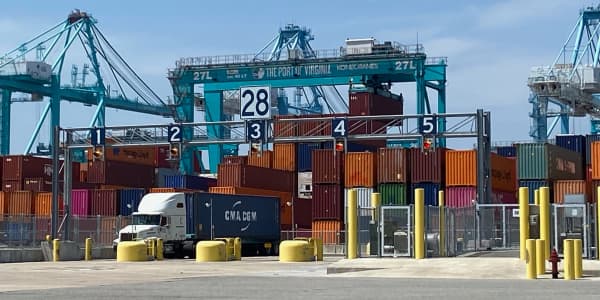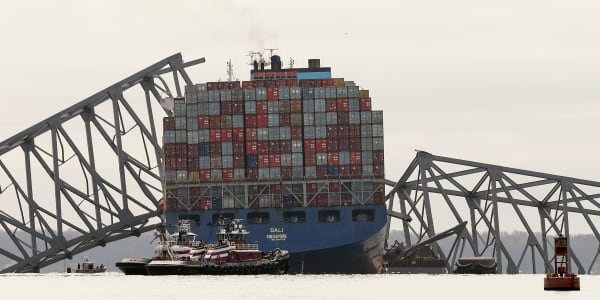
The Panama Canal Authority (PCA) is informing customers their latest conservation efforts to save water will include reducing the number of daily transits mostly in its Panamax locks to 32 to 30 transits a day compared to its usual 36 to 34 transits a day, CNBC has learned.
The Panamax locks lose more water compared to the Neo-Panamax lock. The Neo-Panamax locks have a water recovery system where it can reclaim 60% of the water used during a vessel's transit through the locks. According to the PCA, it takes around 50 million gallons of fresh water to move a vessel through one of the locks. The Panamax lanes do not have the water-recapturing ability of the Neo-Panamax locks.
This reduction in vessel transits will allow the PCA to conserve enough water to postpone the water depth restrictions which would impact how much freight a vessel can carry. Restrictions were expected to start Sunday, June 25, which would equate to an approximate 40% drop in cargo on some containerships.
Even with the restrictions no longer in effect, however, current vessels transversing the canal or presently en route are presently 40% lighter in load because they were loaded weeks ago in Asia to meet the restriction requirements. PCA officials tell CNBC if they do make an announcement on water depth restrictions it would be no later than 21 days prior to enforcement in light of the length of a vessel loading and voyage time. The water levels are constantly monitored to ensure fluidity and communication with customers.
Even though the restrictions have not taken effect, the drop in cargo-carrying capacity will make it more expensive for shippers to move containerized goods, and hit many key sectors of the U.S. economy — from agriculture to energy and retail. The Panama Canal is the premiere trade gateway used by U.S. shippers for the Gulf and East Coast ports, because of much-needed rain.
Forty percent of all U.S. container traffic travels through the Panama Canal every year, which in all, moves roughly $270 billion in cargo annually.
"The U.S. is the main the main source and destination of our traffic," said Ricaurte Vásquez Morales, administrator of the Panama Canal Administrator. "When you combine all of the commodities and containers to the U.S. it represents about 73% of our traffic. We keep in constant communications with our customers and cargo owners in order to make sure that they know where we're standing," he said.
The Panama Canal is popular for East Coast trade because it is faster than other options. The shipping time for ocean cargo from Shenzhen, China, to Miami, Florida, using the Suez Canal takes 41 days. Traveling through the Panama Canal, which is more expensive, takes only 35 days.
But U.S. shippers and industry analysts are concerned about additional freshwater surcharges being imposed because of the drop in water levels. Fees have already been rising. In 2020, the canal imposed a fixed charge of $10,000 per transit along with a toll on a percentage of the carrying capacity of the vessel. That toll could be a minimum of one percent to a maximum of 10 percent.
The waterway is one of the fastest and least expensive ways to move grain and other agricultural commodities which leave the port of New Orleans to go to China. The Agriculture Transportation Coalition, which represents U.S. ag exporters, told CNBC the light loading will increase transportation costs for all cargoes, including U.S. agriculture shipments in both eastbound and westbound directions.
The U.S. is the largest country to move energy commodities through the Panama Canal, including natural gas. A little over one-quarter (26%) of canal transit involves LPG carriers, ocean ships which transport liquified petroleum gas, liquified natural gas, compressed natural gas, and liquefied chemical gases in bulk. LNG vessels will not be impacted by the latest requirements, but canal congestion caused by the lower water levels and the increase in small vessels using the canal has led LNG Allies, the U.S. industry trade group, to publicly comment that it is concerned about future congestion and rising costs, and the need for alternate trade routes that would add time to voyages.
Vásquez said that even before the water restrictions, there was a shift towards using smaller vessels by U.S. shippers because of the congestion at larger U.S. ports, as more chose to route the smaller vessels to secondary ports including Mobile, Alabama, which could handle the smaller vessels and were close to distribution centers.
But he indicated that the Panama Canal's management is worried about the impact of escalating fees, and shippers and industry seeking alternate trade routes.
"We are going to make a presentation to our board of directors this month," he said, adding that an action plan is being developed. "In all the considerations that we have, I think that it is probable that we will give a break to our customers," Vásquez said. "I think that we have to give a break to the industry in order to assure that we remained a viable route in the long term."
In 2021, the world saw firsthand what a canal disruption can do to the supply chain when the Ever Given became stuck in the Suez Canal for six days blocking a whopping $400 million an hour in trade.
The Panama Canal Authority strategy to address similar situations was a February announcement of a canal disruption tariff ranging from $15,000 to $250,000 on any vessels that get stuck and prohibit the flow of vessels through the waterway. But the drought issues and low water levels are adding to the challenges.
The canal has been battling drought conditions for years, but droughts have worsened and there are now increased fears of water levels being too low and the steps that canal administration will need to consider.
"The first water surcharge was for a different reason but now it's so severe [drought] that we may have to revisit that alternative as well," Vásquez said. "So this is probably something that we're gonna discuss to put it in effect for next fiscal year, effective October 1."
At least four ocean carriers imposed container fees between $300 and $500 per box, effective June 1, in response to the canal's measures. More carriers are likely to follow suit as restrictions ramp up.
Because of weight limitations and the size of vessels allowed to traverse the canal, shippers must use more containers and more ships, and vessel wait times are expected to increase and be more expensive. Logistics managers tell CNBC the use of additional containers will take on an additional shipping cost of $1,500.
"The lower levels of water within the Panama Canal system continue to impact pricing for cargo moving from Asia to the USEC," said Alan Baer, CEO of OL USA. He said some surcharges have been abating, but the weight restrictions imposed by some carriers still exist, and these issues won't go away. "Certainly, the long-term issue of how environmental changes are connecting with global supply chains will need to be analyzed," he said.
Logistics costs were a primary contributor to inflation in recent years and have been noted by Federal Reserve Chair Jerome Powell as an inflationary pressure central banks cannot control.
"Panama Canal surcharges and vessel restrictions will likely mean higher clothing and shoe prices for U.S. consumers this holiday season," said Stephen Lamar, President and CEO of the American Apparel & Footwear Association. "Now is not the time to further stress supply chains that are still straining under ongoing logistical pressures."
Vásquez, an economist and former CEO of GE Central American and Caribbean, is attuned to both the short-term challenges and long-term factors. "We believe that climate change is going to impose a significant increase in costs, and transportation costs," Vásquez said. "Resources are going to be allocated differently because there is a movement of nearshoring and production closer to the consumption markets."
In September 2020, the Panama Canal Authority announced it would invite bidders to submit projects to design and build a new water management system. The plans remain under cost and design review by the PCA and the U.S. Army Corp of Engineers. The PCA has budgeted $2 billion for the project, for which 250 potential bidders have expressed interest. In June 2021, the canal authority said it would provide a more detailed concept. To date, no work on a new water management system has begun.





